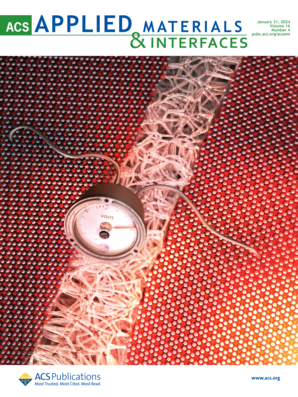非传统硫胺基1-苯基2-硫脲调平剂用于微孔无空隙填充的作用机理研究
IF 8.3
2区 材料科学
Q1 MATERIALS SCIENCE, MULTIDISCIPLINARY
引用次数: 0
摘要
调平剂是实现电子元件高密度集成微孔无空隙填充,实现电子器件小型化、轻量化、智能化发展的关键添加剂。传统的有机匀平剂多为季铵盐和含氮杂环化合物。本文首次将氨基和苯基取代基不同的硫氨基化合物硫脲(TA)和1-苯基2-硫脲(PTA)作为调平剂,应用于酸性电镀铜(Cu- ep)硫酸铜浴的微孔填充。结果表明,只有以PTA为调平剂,以聚乙二醇(PEG)为抑制剂,双硫丙基钠(SPS)为促进剂,才能实现微孔无空隙填充。时间电位分析表明,TA和PTA均能加速铜离子的还原。SPS的加速剂与TA的协同作用增强了加速效果,与PTA的竞争吸附作用减弱了加速效果。PEG抑制因子可与PTA协同作用,对铜离子还原表现出较强的抑制作用,但与TA呈竞争性吸附,削弱了PEG的抑制作用。在这些添加剂的复杂相互作用下,我们发现只有PTA、SPS和PEG的组合表现出对流依赖的吸附行为,这导致微孔口处铜离子的负还原电位大于微孔底处的负还原电位,表明实现微孔无空隙填充在理论上是可行的。循环伏安实验进一步证明,PTA可以加速铜离子的还原,但由于SPS的竞争吸附,这种加速作用被削弱。PTA与PEG的协同作用大大增强了对铜离子还原的抑制作用。根据添加剂的电化学性能和相互作用,通过电镀模拟阐明了pta基酸性硫酸铜浴实现微孔无空隙填充的本质。当三种添加剂同时存在时,PTA-PEG的吸附覆盖率从嘴部到底部逐渐减小。由于PTA-PEG具有协同抑制作用,该梯度显著抑制Cu在口腔的沉积;同时,SPS的吸附覆盖率从壶口到壶底逐渐增大,具有加速作用,有利于壶底铜离子的还原。双梯度效应使微孔无空隙填充成为可能。本文章由计算机程序翻译,如有差异,请以英文原文为准。

Study on the Action Mechanism of a Nontraditional Thioamide-Based Leveler of 1-Phenyl 2-Thiourea for Microvia Void-Free Filling
Leveler is the key additive for achieving microvia void-free filling in the high-density integration of electronic components for miniaturization, lightweighting, and intelligent development of electronic devices. Traditional organic levelers are mostly quaternary ammonium salts and nitrogen-containing heterocyclic compounds. In this study, thiosemicarbazide (TA) and 1-phenyl 2-thiourea (PTA), which are the thioamino compounds with different substituents of amino and phenyl, are used for the first time as levelers for microvia filling in an acidic copper sulfate bath of Cu electroplating (Cu-EP). The results demonstrate that only the PTA, when used as the leveler in combination with poly(ethylene glycol) (PEG) as the suppressor and bis(sodium sulfopropyl)-disulfide (SPS) as the accelerator, can achieve microvia void-free filling. Chronopotentiometric analyses reveal that both TA and PTA accelerate the reduction of cupric ions. The accelerator of SPS with TA synergistically enhances accelerating effect, while with PTA, it behaves with competitive adsorption to weaken this effect. The suppressor of PEG can cooperate with PTA to show a strong inhibiting effect on cupric ion reduction but presents competitive adsorption with TA, weakening the inhibiting effect of PEG. Under such complex interactions of these additives, it has been found that only the combination of PTA, SPS, and PEG exhibits convection-dependent adsorption behavior, which results in a more negative reduction potential of cupric ions at the mouth of the microvia than that at the bottom of the microvia, indicating a theoretical feasibility of achieving microvia void-free filling. Cyclic voltammetry experiments further demonstrate that the PTA can accelerate the reduction of cupric ions, but this acceleration effect is weakened by SPS due to competitive adsorption. PTA synergizes with PEG to greatly enhance the inhibiting effect on cupric ions reduction. According to electrochemical properties and interactions of the additives, the essence of the PTA-based acidic Cu sulfate bath for achieving microvia void-free filling is elucidated through electroplating simulations. When the three additives coexist, the adsorption coverage of PTA–PEG gradually decreases from the mouth to the bottom. As PTA–PEG exhibits a synergistic inhibition effect, such a gradient significantly inhibits Cu deposition at the mouth; simultaneously, the adsorption coverage of SPS, which behaves with an accelerating effect, gradually increases from the mouth to the bottom, facilitating the reduction of cupric ions at the bottom. The dual gradient effects enable the microvia void-free filling.
求助全文
通过发布文献求助,成功后即可免费获取论文全文。
去求助
来源期刊

ACS Applied Materials & Interfaces
工程技术-材料科学:综合
CiteScore
16.00
自引率
6.30%
发文量
4978
审稿时长
1.8 months
期刊介绍:
ACS Applied Materials & Interfaces is a leading interdisciplinary journal that brings together chemists, engineers, physicists, and biologists to explore the development and utilization of newly-discovered materials and interfacial processes for specific applications. Our journal has experienced remarkable growth since its establishment in 2009, both in terms of the number of articles published and the impact of the research showcased. We are proud to foster a truly global community, with the majority of published articles originating from outside the United States, reflecting the rapid growth of applied research worldwide.
 求助内容:
求助内容: 应助结果提醒方式:
应助结果提醒方式:


